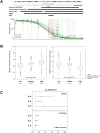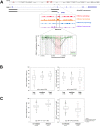Prenatal maternal stress and wheeze in children: novel insights into epigenetic regulation
- PMID: 27349968
- PMCID: PMC4923849
- DOI: 10.1038/srep28616
Prenatal maternal stress and wheeze in children: novel insights into epigenetic regulation
Abstract
Psychological stress during pregnancy increases the risk of childhood wheeze and asthma. However, the transmitting mechanisms remain largely unknown. Since epigenetic alterations have emerged as a link between perturbations in the prenatal environment and an increased disease risk we used whole genome bisulfite sequencing (WGBS) to analyze changes in DNA methylation in mothers and their children related to prenatal psychosocial stress and assessed its role in the development of wheeze in the child. We evaluated genomic regions altered in their methylation level due to maternal stress based of WGBS data of 10 mother-child-pairs. These data were complemented by longitudinal targeted methylation and transcriptional analyses in children from our prospective mother-child cohort LINA for whom maternal stress and wheezing information was available (n = 443). High maternal stress was associated with an increased risk for persistent wheezing in the child until the age of 5. Both mothers and children showed genome-wide alterations in DNA-methylation specifically in enhancer elements. Deregulated neuroendocrine and neurotransmitter receptor interactions were observed in stressed mothers and their children. In children but not in mothers, calcium- and Wnt-signaling required for lung maturation in the prenatal period were epigenetically deregulated and could be linked with wheezing later in children's life.
Figures








Similar articles
-
Parental psychological distress during pregnancy and wheezing in preschool children: the Generation R Study.J Allergy Clin Immunol. 2014 Jan;133(1):59-67.e1-12. doi: 10.1016/j.jaci.2013.04.044. Epub 2013 Jun 15. J Allergy Clin Immunol. 2014. PMID: 23777854
-
Perinatal risk factors for wheezing phenotypes in the first 8 years of life.Clin Exp Allergy. 2013 Dec;43(12):1395-405. doi: 10.1111/cea.12173. Clin Exp Allergy. 2013. PMID: 24261948
-
Preconceptional exposure to oral contraceptive pills and the risk of wheeze, asthma and rhinitis in children.Allergol Int. 2016 Jul;65(3):327-31. doi: 10.1016/j.alit.2016.02.012. Epub 2016 Mar 30. Allergol Int. 2016. PMID: 27038776
-
Prenatal maternal psychological stress and childhood asthma and wheezing: a meta-analysis.Eur Respir J. 2016 Jan;47(1):133-46. doi: 10.1183/13993003.00299-2015. Epub 2015 Nov 5. Eur Respir J. 2016. PMID: 26541526 Review.
-
Epidemiology of asthma and recurrent wheeze in childhood.Clin Rev Allergy Immunol. 2002 Feb;22(1):33-44. doi: 10.1007/s12016-002-0004-z. Clin Rev Allergy Immunol. 2002. PMID: 11803801 Review.
Cited by
-
Association of Maternal Psychosocial Stress With Increased Risk of Asthma Development in Offspring.Am J Epidemiol. 2018 Jun 1;187(6):1199-1209. doi: 10.1093/aje/kwx366. Am J Epidemiol. 2018. PMID: 29244063 Free PMC article.
-
Epigenetic effects of endogenous and exogenous glucocorticosteroids during pregnancy on the offspring: a systematic-narrative review.Hormones (Athens). 2025 Jun 21. doi: 10.1007/s42000-025-00671-1. Online ahead of print. Hormones (Athens). 2025. PMID: 40542332 Review.
-
Exposure to Violence, Psychosocial Stress, and Asthma.Am J Respir Crit Care Med. 2020 Apr 15;201(8):917-922. doi: 10.1164/rccm.201905-1073PP. Am J Respir Crit Care Med. 2020. PMID: 31801032 Free PMC article. Review. No abstract available.
-
Cumulative lifetime maternal stress and epigenome-wide placental DNA methylation in the PRISM cohort.Epigenetics. 2018;13(6):665-681. doi: 10.1080/15592294.2018.1497387. Epub 2018 Aug 15. Epigenetics. 2018. PMID: 30001177 Free PMC article.
-
The neonatal methylome as a gatekeeper in the trajectory to childhood asthma.Epigenomics. 2017 Apr;9(4):585-593. doi: 10.2217/epi-2016-0149. Epub 2017 Mar 21. Epigenomics. 2017. PMID: 28322586 Free PMC article.
References
-
- Mathilda Chiu Y. H., Coull B. A., Cohen S., Wooley A. & Wright R. J. Prenatal and postnatal maternal stress and wheeze in urban children: effect of maternal sensitization. American Journal of Respiratory and Critical Care Medicine 186, 147–154, doi: 10.1164/rccm.201201-0162OC (2012). - DOI - PMC - PubMed
-
- de Marco R. et al.. Foetal exposure to maternal stressful events increases the risk of having asthma and atopic diseases in childhood. Pediatric Allergy and Immunology: Official Publication of the European Society of Pediatric Allergy and Immunology 23, 724–729, doi: 10.1111/j.1399-3038.2012.01346.x (2012). - DOI - PubMed
Publication types
MeSH terms
LinkOut - more resources
Full Text Sources
Other Literature Sources
Medical

